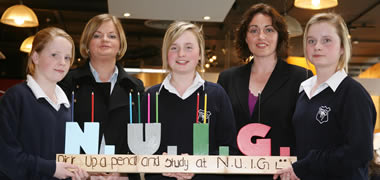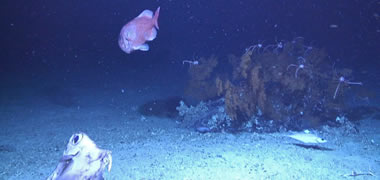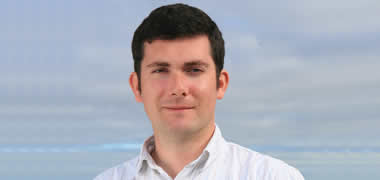-
Courses

Courses
Choosing a course is one of the most important decisions you'll ever make! View our courses and see what our students and lecturers have to say about the courses you are interested in at the links below.
-
University Life

University Life
Each year more than 4,000 choose University of Galway as their University of choice. Find out what life at University of Galway is all about here.
-
About University of Galway

About University of Galway
Since 1845, University of Galway has been sharing the highest quality teaching and research with Ireland and the world. Find out what makes our University so special – from our distinguished history to the latest news and campus developments.
-
Colleges & Schools

Colleges & Schools
University of Galway has earned international recognition as a research-led university with a commitment to top quality teaching across a range of key areas of expertise.
-
Research & Innovation

Research & Innovation
University of Galway’s vibrant research community take on some of the most pressing challenges of our times.
-
Business & Industry

Guiding Breakthrough Research at University of Galway
We explore and facilitate commercial opportunities for the research community at University of Galway, as well as facilitating industry partnership.
-
Alumni & Friends

Alumni & Friends
There are 128,000 University of Galway alumni worldwide. Stay connected to your alumni community! Join our social networks and update your details online.
-
Community Engagement

Community Engagement
At University of Galway, we believe that the best learning takes place when you apply what you learn in a real world context. That's why many of our courses include work placements or community projects.
2009
All 2009
Obama Administration Using Technology Developed at NUI Galway

Thursday, 2 April 2009
An internet technology developed at NUI Galway is to be used by President Obama's administration in its new website devoted to the $800 billion economic stimulus package. The administration's 'Recovery.gov' site will employ a web standard, created at NUI Galway's Digital Enterprise Research Institute (DERI), to bring an unprecedented level of transparency to the US Government. Researchers at DERI focus on the Semantic Web, which is the next incarnation of the internet which will be more intuitive because data will be defined and linked. One of the outputs of DERI's research is called Semantically-Interlinked Online Communities or SIOC. Aimed at connecting online community sites and internet-based discussions, SIOC is set to be utilised by 'Recovery.gov'. Creator of SIOC and lecturer in Electronic Engineering at NUI Galway, Dr John Breslin, said: "The possibilities afforded by deploying semantic technologies such as SIOC for government transparency are very exciting. Semantic technology allows the linking of government funding data, fed in from spreadsheets or forms, to contributions from the public, private organisations or the government themselves. This can be done not just within a single site but with external linked data from other public sources. You could imagine using this to discover the effect of how and where tax dollars and Euros are being spent on statistics for crime, education or innovation in a set of geographic regions". As announced by George Thomas, Chief Architect with the US General Services Administration, the Recovery.gov effort will bring transparency to the government towards allowing citizens and activists to access semantic data about everything from contracts and schedules to training and infrastructure costs. Since 2003, DERI has been supported by Science Foundation Ireland with a Centre for Science, Engineering and Technology grant. During this time, DERI has grown to over 120 members. Professor Stefan Decker, Director of DERI, says: "This is another example showing that investment in science and research has truly propelled Ireland into the forefront of technology. Our technology can bring a greater level of transparency and trust to governments as well as financial institutions - something that becomes increasingly important. The US Government has recognised this already". The SIOC project from DERI at NUI Galway is already being used by a range of applications including Yahoo! SearchMonkey and Drupal. -ends-
>> Read full story about Obama Administration Using Technology Developed at NUI Galway
NUI Galway Alumni Host Lisbon Debate with Pat Rabbitte and Declan Ganley

Thursday, 2 April 2009
Former Labour Party leader Pat Rabbitte T.D. and founder and Chairman of Libertas, Declan Ganley will debate the second Lisbon Referendum on Wednesday, 8 April, in the Davenport Hotel, Merrion Square, Dublin at 7pm. The debate will be hosted by the NUI Galway Alumni Association and moderated by alumni member and Irish Times Political Correspondent Harry McGee. RTÉ Radio presenter and NUI Galway alumni member Sean O'Rourke said of the event: "We're delighted to have these two distinguished speakers; it should make for a very interesting debate". Businessman Declan Ganley is the founder of the Libertas movement which lobbied against the adoption of the Treaty of Lisbon in Ireland in 2008. Mr Ganley recently launched his campaign to contest the European elections in June in the Connacht-Ulster constituency. Referring to the Lisbon Treaty, he said: "We are giving up an enormous amount of control over our own affairs and we are getting nothing in return". Pat Rabbitte T.D., who will speak in favour of the Treaty at the event, recently spoke on the danger of the economic situation and noted that early ratification of the Treaty would help to restore international confidence in Ireland. The NUI Galway Dublin Alumni Group runs several events annually, aimed at bringing together graduates of NUI Galway. Tickets for the event will be allocated on a first-come, first-served basis to graduates of NUI Galway who apply via email to colm.odwyer@nuigalway.ie or by phone on 091 493750. -ends-
>> Read full story about NUI Galway Alumni Host Lisbon Debate with Pat Rabbitte and Declan Ganley
Record Numbers Participate in Schools Art Competition

Friday, 29 May 2009
A record number of over 430 students from 14 Galway secondary school schools participated in this years' NUI Galway First Year Schools Competition. The competition is part of the University Trail Access Programme designed to encourage an interest in third-level education among students in selected Secondary Schools in Galway City and County. The programme is supported by the HEA targeted funding for special initiatives. For the competition, students were asked to express through Art, Music, Drama and Writing why they believe they would like to study at university and what it would mean to their future. Ashla Ward, of NUI Galway's Access office, commented, "The Access programme is all about enabling secondary school pupils to envisage their future at third-level and to support their studies in secondary school. One of the reasons for the competition's success over the last seven years has been the commitment of the teachers. We also need to thank the NUI Galway students who have volunteered on the schools programme down through the years by meeting with secondary school pupils and encouraging them in their education choices". NUI Galway's University Trail starts with the First Year School Competition and continues in second, third, fifth and on to the Leaving Certificate year, with a series of activities such as campus tours, mentoring and Study Skills Workshops. The main objective is to promote regular interaction between the students and the University. The effectiveness of this initiative has been greatly enhanced by the ongoing support of management and staff in the participating schools. -Ends-
>> Read full story about Record Numbers Participate in Schools Art Competition
New and Spectacular Deep-water Coral Province Discovered off the West Coast of I

Tuesday, 26 May 2009
(Leagan Gaeilge) NUI Galway researchers, during a recent deep-water expedition, have confirmed the existence of a major new coral reef province on the southern end of the Porcupine Bank off the west coast of Ireland. The province covers an area of some 200 sq.km and contains in the order of 40 coral reef covered carbonate mounds. These underwater hills rise as high as 100m above the seafloor. The deep-water research expedition took place earlier this month aboard the Marine Institute research vessel, the RV Celtic Explorer*. The research used the new national Remotely Operated Vehicle (ROV) Holland I** to survey the seafloor and capture unique video footage. The expedition, led by Dr Anthony Grehan, was a collaboration between NUI Galway and the Institut Français de Recherche pour l'Exploitation de la Mer (IFREMER) and involved researchers and students from both institutions. Dr Anthony Grehan, NUI Galway, said: "These are by far the most pristine, thriving and hence spectacular examples of cold-water coral reefs that I've encountered in almost ten years of study in Irish waters. There is also evidence of recent recruitment of corals and many other reef animals in the area suggesting this area is an important source of larvae supply to other areas further along the Porcupine Bank". Dr Grehan suggested that given the rugged terrain, its unsuitability for trawling and its well defined boundaries, that the area would be an excellent additional candidate to the four existing off-shore coral Special Areas of Conservation (SAC). He said that NUI Galway's Department of Earth and Ocean Sciences would in due course provide a copy of all video footage to the National Parks and Wildlife Service to facilitate them in their work of further SAC designations to comply with the European Union s Habitat Directive. The expedition began in French waters with a series of ROV dives in previously unexplored canyons in the Bay of Biscay which confirmed the presence of coral and geogenic reefs that will be notified to the new French Marine Protected Area Agency. Dr Brigitte Guillaumont from the newly established agency, said: "The video and images obtained from the high definition video camera of the Irish ROV are very impressive and will greatly assist us in our work of designating areas for the protection of corals". Moving into Irish waters, the use of high resolution bathymetry charts, provided by the Irish National Seabed Survey, a collaboration between the Geological Survey of Ireland and the Marine Institute, enabled the identification of new areas likely to support coral reefs. The ROV was then used to dive on one of these areas, the Archipelagos Mounds (or Arc Mounds), to reveal a seascape of spectacular coral reefs. Anna Rensdorf, a Griffith Geoscience PhD student in the Department of Earth and Ocean Sciences, NUI Galway, who had previously worked on tropical corals, said: "I can't believe that coral reefs like these can be found in the cold waters of Ireland. On many of the mounds surveyed, living coral thickets stood up to 2m high where ordinarily they are less than half a metre in height". The NUI Galway study is part of a larger pan-European project funded by the European Commission's 7th research Framework Programme, called 'CoralFISH' that is studying in detail the interactions between corals, fish and fisheries. Dr Grehan, coordinator of the European study, said: "At the recent International Council for the Exploration of the Sea (ICES) deep-sea symposium delegates expressed increasing concern about the level of bottom fishing related damage sustained by vulnerable marine ecosystems (VMEs) in the High Seas (i.e. areas beyond national jurisdiction). Because cold-water corals remain the best example of VMEs, much research is focused on them. One of the key areas in the management of fisheries now appears to be improving our understanding of how fish use habitat. We need to understand what effect damage or removal of that habitat will have on fish stocks and communicating that knowledge to fishermen". Dr Grehan noted that vulnerable marine ecosystems such as coral reefs represent one of the last untapped reservoirs of potentially useful bio-compounds that might support the development of new anti-viral or anti-bacterial pharmaceuticals. Currently, there is a major biodiscovery programme underway at NUI Galway funded through the Marine Institute under Sea Change – A Marine Knowledge, Research and Innovation Strategy for Ireland 2007-2013. For more information on the Celtic Explorer survey and the CoralFISH project please visit the project website: http://eu-fp7-coralfish.net Coiréal domhainmhara aimsithe amach ó chósta thiar na hÉireann (View in English) Le linn do thaighdeoirí ó OÉ Gaillimh a bheith ar thuras taiscéalaíochta domhainmhara le déanaí, dhearbhaigh siad go bhfuil limistéar iontach nua de sceir choiréil aimsithe acu ó dheas de Bhanc an Torcáin amach ó chósta thiar na hÉireann. 200 ciliméadar cearnach atá sa limistéar agus tá thart ar 40 mullóg carbónáite faoi chumhdach sceir choiréil ann. Tá cuid de na mullóga fomhuirí seo beagnach 100 méadar os cionn ghrinneall na farraige. Thug taighdeoirí ó OÉ Gaillimh faoin turas taiscéalaíochta taighde domhainmhara níos túisce an mhí seo ar bord bhád taighde Fhoras na Mara – an RV Celtic Explorer*. Nuair a bhí an taighde ar bun baineadh úsáid as an bhFeithicil Chianoibrithe nua náisiúnta (ROV) – Holland I** – chun grinneall na farraige a scrúdú agus na híomhánna a thaifeadadh. Ba é an Dr Anthony Grehan a bhí i gceannas ar an turas taiscéalaíochta seo, comhfhiontar idir OÉ Gaillimh agus an Institut Français de Recherche pour l'Exploitation de la Mer (IFREMER), agus ghlac idir thaighdeoirí agus mhic léinn ón dá institiúid páirt sa turas taiscéalaíochta spéisiúil seo. Bhí an méid seo a leanas le rá ag an Dr Anthony Grehan: "Tá beagnach deich mbliana caite agam anois i mbun staidéir ar uiscí na hÉireann agus níl dabht ar bith faoi ach gurb iad seo na samplaí is glaine, is rafaire, agus is spéisiúla de sceireacha coiréil fuaruisce atá feicthe agam in imeacht deich mbliana. Tá fianaise ann freisin de choiréil nua agus go leor ainmhithe sceire eile, rud a thugann le fios gur foinse thábhachtach larbhaí é an limistéar seo le haghaidh limistéir eile atá suite feadh Bhanc an Torcáin". Bhí an Dr Grehan den bharúil ó tharla an tír-raon a bheith chomh garbh, deacrachtaí a bheith ag baint le trálaeireacht agus teorainneacha dochta daingne, go mbeadh an limistéar seo rífheiliúnach mar iarrthóir breise le cur leis na ceithre Limistéar Caomhantais Speisialta coiréil amach ón gcósta atá ann cheana féin. Dúirt sé go mbeadh Roinn Domhaneolaíochta agus Aigéaneolaíochta OÉ Gaillimh in ann cóip den fhíseán a rinneadh i rith an turais a thabhairt don tSeirbhís Páirceanna Náisiúnta agus Fiadhúlra d'fhonn cabhrú leo Limistéir Chaomhantais Speisialta nua a ainmniú. Cuireadh tús leis an turas seo in uiscí na Fraince nuair a rinneadh roinnt tumthaí ROV i gcainneoin i mBá na Bioscáine, cainneoin nach raibh mórán taiscéalaithe déanta orthu. Aimsíodh sceireacha coiréil agus geoigineacha agus cuirfear sonraí na sceireacha seo in iúl do Ghníomhaireacht Limistéir Chaomhantais Mhuirí na Fraince. Bhí an méid seo a leanas le rá ag an Dr Brigitte Guillaumont ó IFREMER: "Tá an físeán agus na híomhánna atá ar fhíscheamara ardghléine ROV na hÉireann iontach ar fad agus is cinnte go gcabhróidh an t-ábhar seo linn leis an obair atá ar bun againn limistéir a ainmniú agus coiréil a chosaint". Le linn don bhád a bheith ag tarraingt ar uiscí na hÉireann, baineadh úsáid as léarscáileanna bataiméadracha, a fuarthas ó Shuirbhé Náisiúnta Grinnill Farraige na hÉireann Shuirbhéireacht Gheolaíochta na hÉireann agus Fhoras na Mara, chun limistéir nua ar dócha go mbeadh sceireacha coiréil iontu a aimsiú. Baineadh úsáid as ROV ansin le turas tumtha a thabhairt ar cheann de na limistéir seo, Mullóga Archipelagos (mullóga Arc), limistéar ina bhfuil sceir choiréil iontach le feiceáil. Bhí an méid seo a leanas le rá ag Anna Rensdorf, mac léinn PhD Griffith sa Gheo-Eolaíocht ó Roinn Domhaneolaíochta agus Aigéaneolaíochta OÉ Gaillimh, a chaith seal ag obair ar choiréil thrópaiceacha: "Is deacair a chreidiúint go bhfuil sceireacha coiréil cosúil leis na cinn seo le fáil i bhfuaruisce na hÉireann. Ar fhormhór na mullóg a ndearnadh suirbhé orthu, bhí mothair choiréil bheo a bhí suas le 2 mhéadar ar airde; is gnách go mbíonn mothair choiréil níos lú ná leathmhéadar ar airde". Áirítear staidéar OÉ Gaillimh mar chuid de thionscadal mór uile-Eorpach atá á mhaoiniú trí 7ú Clár Creata an Choimisiúin Eorpaigh, clár ar a dtugtar 'CoralFISH' agus a bhfuil sé mar aidhm leis mionstaidéar a dhéanamh ar an idirghníomhaíocht a bhíonn idir coiréil, éisc agus iascaigh. Bhí an méid seo a leanas le rá ag an Dr Grehan, comhordaitheoir an staidéir Eorpaigh: "Ag an gComhairle Idirnáisiúnta um Thaiscéalaíocht na Farraige (ICES) léirigh toscairí ón earnáil dhomhainfharraige a bhí i láthair ag an siompóisiam imní maidir leis an leibhéal damáiste a rinne iascaireacht ghrinnill d'éiceachórais mhuirí shomhillte sa Mhórmhuir (i.e. limistéir nach n-áirítear sa dlínse náisiúnta). De bhrí gurb iad na coiréil fhuaruisce na samplaí is fearr d'éiceachórais mhuirí shomhillte, déantar go leor taighde orthu. Tá an chosúlacht ar an scéal anois gurb é ceann de na príomhréimsí a bhaineann le bainistíocht na n-iascach an tuiscint atá againn ar an úsáid a bhaineann éisc as an ngnáthóg a fheabhsú. Ní mór dúinn tuiscint a bheith againn ar an éifeacht a bheidh ag damáiste a dhéanamh don ghnáthóg nó go deimhin scriosadh na gnáthóige ar stoc éisc agus an méid sin a chur in iúl do na hiascairí". Tharraing an Dr Grehan aird ar an bpointe go n-áirítear éiceachórais mhuirí shomhillte, dála sceireacha coiréil, i measc ceann de na foinsí bith-chomhdhúile a d'fhéadfaí a úsáid i bhforbairt cógaisíochtaí nua frithbhaictéaracha nó frithvíreasacha. I láthair na huaire, tá clár suntasach bithfhionnachtana ar siúl in OÉ Gaillimh, clár atá á mhaoiniú ag Foras na Mara faoi Sea Change – Straitéis Eolais, Taighde agus Nuálaíochta Mhuirí d'Éire 2007-2013. Tá tuilleadh eolais faoi shuirbhé an Celtic Explorer agus tionscadal CoralFISH le fáil ar láithreán gréasáin an tionscadail: http://eu-fp7-coralfish.net . -Críoch-
>> Read full story about New and Spectacular Deep-water Coral Province Discovered off the West Coast of I
NUI Galway Lecturer wins Outstanding Young Person of the Year Award

Monday, 25 May 2009
Dr David Finn, Lecturer in Pharmacology and Therapeutics, Science Foundation Ireland Principal Investigator and co-director of the Centre for Pain Research at NUI Galway, has received an award from Junior Chamber International (JCI) Ireland as one of Ireland's Ten Outstanding Young Persons (TOYP) of the year aged 18-40. He was awarded winner of the Scientific Development category on the basis of academic and scientific achievements and community service/civic engagement in his research. Dr Finn will now represent Ireland in this category in the World JCI TOYP competition. By recognising the achievements of young people, JCI encourages them and others to seek excellence and serve others. It's just one way that JCI contributes to preparing better leaders, who will create better societies. Awards are made in ten categories, which also include personal accomplishment; cultural achievement; political, legal and/or governmental achievement; and voluntary leadership. Dr Finn, originally from Ballycahill, Thurles, Co. Tipperary, was nominated by JCI Galway for his contribution to neuroscience and pain research. Local JCI president, Brenda Gannon says: "We are delighted to nominate a high calibre scientist and researcher from NUI Galway, and we have great hopes for Dr Finn to succeed at the international event". On receiving the award in Dublin, Dr Finn addressed the audience about his work and gave significant note of thanks to past and present mentors, to NUI Galway colleagues and collaborators, and the members of his research team. Dr Finn also acknowledged research funding received from Science Foundation Ireland, the Health Research Board, the Higher Education Authority, the Irish Research Council for Science Engineering and Technology and the International Association for the Study of Pain. President of NUI Galway, Dr James J. Browne, said: "On behalf of NUI Galway, I extend warmest congratulations to David Finn on this wonderful distinction. David is a very talented researcher and is committed to sharing his knowledge and skills with the wider community, reflecting NUI Galway's strong ethos of civic engagement. This Junior Chamber Ireland Award is a tremendous recognition of David's work and service to society". -Ends-
>> Read full story about NUI Galway Lecturer wins Outstanding Young Person of the Year Award















